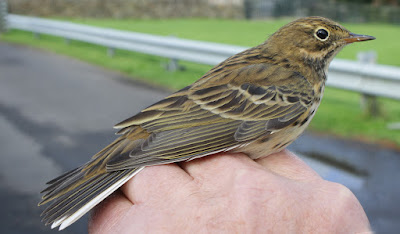3 hours ago
Wednesday, September 25, 2019
Sunday, September 8, 2019
Linnets Minus One
As a light sleeper I’m often awake early. A look at the breaking dawn of Sunday revealed clear skies and no wind - a morning to revisit those darned Linnets that are up to their old tricks of playing hard to get.
If anything the Linnets are proving more difficult to catch than last season. There is such an abundance of food in the plot that the birds are free to land and to feed anywhere and it is not often they feed very close to the double net ride we established. The count was between 150 and 200 very flighty Linnets and a catch of just four, all males but including the first adult male of this winter’s project. To date we have 24 captures - 18 first year males, 5 first year females and 1 adult male. And to date, and as we might expect, no larger “Scottish” Linnets yet with all 24 birds recorded as wing lengths of 83 mm or less.
Linnet- adult male
At one point a male Sparrowhawk appeared and panicked the feeding Linnets into flight. The hawk seemed to have no trouble in identifying a Linnet to chase. After a brief flight the hawk caught the Linnet on the wing, dropped to the roadside, subdued the Linnet and then flew off carrying its meal. We lost a Linnet to a hawk and it’s for sure that this and similar flocks of birds will always attract predators. Such is the balance of nature.
Soon after the Sparrowhawk had flown the flock of Linnets panicked again when a Marsh Harrier appeared, flying slowly from the sea wall in the east and then over the busy A588 next to Gulf Lane. It followed the ditch, circled the seed plot once, flew lazily across the road, out towards the sea wall and on a direct path towards the plantation at Pilling Lane Ends. The harrier was all dark with no hint of grey in the wings and little or no cream crown - a youngster of the year.
Marsh Harrier
Less than two minutes later came another raptor following the same flight path alongside the still wet ditch that lines the seed plot. This bird was much paler than the previous and at first glance I assumed it would be a local Buzzard. But no, as the bird slowed, twisted, and held its wings in that diagnostic shallow “V”, it became another Marsh Harrier, this one a tri-coloured type with a cream crown, paler underneath and a well-marked area of grey in each wing.
This additional harrier was probably a second year male, perhaps even a family traveller in the company of the first bird a minute earlier. Within a few seconds it had drifted over the farm buildings and off in the general direction of Pilling village.
The Marsh Harrier is best described as “scarce” in this part of Lancashire so a sighting is always welcome, two even more so.
Marsh Harrier
The Marsh Harrier Circus aeruginosus is typically illustrated in field guides as a sexually dimorphic species, with several age classes identifiable by differences in plumage pattern and colour. In some populations, however, such as one studied in west-central France, (British Birds March 2013), the species can show extreme plumage variability in adult males and, to a lesser extent, in adult females.
The study population was markedly polymorphic, with highly distinct patterns of coloration and almost continuous individual variation between those different morphs. Barely a single adult male looked like a typical ‘field-guide male’. Since this plumage variability was independent of age and sex, the authors considered it almost impossible to age birds solely from their plumage, which contradicts the established view. The authors advocated the recognition of this species as polymorphic, at least in some parts of its range.
Back soon with more news and views on Another Bird Blog.
Labels:
Circus aeruginosus,
Linnet,
Marsh Harrier
Saturday, September 7, 2019
Spotted Saturday
If August is predictable as warblers and Swallows journey south to Africa, September is less so.
Just this week saw the first returning Pink-footed Geese when a gaggle of around 200 flew over Pilling and then to the salt marsh beyond; the geese seem to arrive earlier each year. And then the weather turned more autumnal with strong winds and high tides that blew petrels, skuas, manxies, fulmars and gulls closer to shore.
Manx Shearwater
Pink-footed Goose
On Saturday came a break in the squalls when a ridge of high pressure built from the North West. With it came a chance of ringing at Oakenclough but with less certainty about what we might catch given the arrival of September. Would it be a morning of finches, warblers, pipits and wagtails, or perhaps a mix with a few of each?
It was 0600 when Andy and I met at the ringing station to a cold easterly and 9 degrees C. The cold start gave a slow opening to the catch but as the morning warmed more birds arrived, especially the diurnal migrant, Meadow Pipit. Missing from our catch today were Willow Warblers, a regular feature here during June, July and August, but replaced now by Goldcrests, a September species for sure.
The really noticeable migrant today was Meadow Pipit with a count of 100+ in steady and small arrivals from the north, a number reflected in our catch of 36 birds and 8 species - 14 Meadow Pipit, 6 Goldcrest, 5 Blackcap, 3 Chiffchaff, 2 Spotted Flycatcher, 2 Goldfinch, 2 Robin, 1 Blue Tit, 1 Chaffinch.
The surprise bird today was Spotted Flycatcher, not one but two individuals, both first years, but caught three hours apart. It’s a species that we catch quite rarely although we suspect that some bred quite close to here this year.
Spotted Flycatcher
The Chiffchaff wing shows a shape and formula that is quite different to its close relative the Willow Warbler i.e. the short 2nd primary feather, “rounded” wing shape (3, 4 and 5 of very similar length), and emargination to the 6th primary feather.
Chiffchaff
Chiffchaff
Below is the wing of an adult Meadow Pipit that displays uniform olive tones, the squared olive/buff tips to the median coverts without “teeth”, well-defined margins of the greater coverts, plus tertials all of the same age.
Ageing Meadow Pipits can be more difficult when birds born early in the season display many characteristics of adults, with sometimes just a few pale buff juvenile feathers left. The fourteen Meadow Pipits today split 11/3 in favour of first years but similarly sized catches might easily contain no adults, especially so as autumn progresses.
Meadow Pipit
Meadow Pipit
All of our Blackcaps were first year birds, four female, one male, and one likely male with hints of a black cap.
Blackcap
Other birds today - 2 Jay, 15+ Swallow, 2 Great-spotted Woodpecker, 1 Nuthatch.
Linking this post to Anni's Saturday Birding.
Linking this post to Anni's Saturday Birding.
Monday, September 2, 2019
Wheat’s It All About?
Monday was the last of our child minding for the summer holidays, so I couldn’t make it up to Oakenclough where the long drive there and back makes for half a day’s commitment.
Instead I made a 15 minute drive to Gulf Lane and grabbed an hour or two ringing at the Linnets with the aim of being home for breakfast. On 24th August there was a count of 160/185 Linnets, but today more like 70/80, an unexpected drop in numbers for this time of year perhaps explained by the current availability of food in the wider countryside.
At 0900 the sky blackened from the North-West as a downpour arrived and forced an early end to my meagre catch of 6 Linnets, all first years, three of each sex, plus a single first year Reed Bunting.
Reed Bunting
Linnet
A text from Andy advised that the downpour had reached Oakenclough, soaked him to the skin and he was packing in. Did I laugh? - just a little. But he'd caught a few goodies by way of 1 Tree Pipit, 3 Willow Warblers, a Chiffchaff, a Meadow Pipit and two smart looking Bullfinch.
Bullfinch
Meanwhile just half a mile from Gulf Lane the appearance of a rare bird at Fluke Hall this weekend provoked a flood of twitchers to this otherwise quiet, mostly unmolested part of Wyre.
A wheatear species first spotted along the sea wall on 1st September and identified as an adult female Eastern Black-eared Wheatear continues to create discussion and not a little controversy, even down to birders collecting a faeces sample from the bird’s rocky shore hangout for later DNA analysis.
Poo sample
The controversy centres around the fact that the autumnal Pied Wheatear Oenanthe pleschanka and the autumnal Black-eared Wheatear Oenanthe hispanica melanoleuca look remarkably similar, so much so that such occurrences sometimes remain unassigned.
For what it’s worth, having studied the individual involved, plus a read of the Ringer’s Bible Svensson. My own thoughts were firstly that the bird was clearly a first summer/juvenile, and not an adult ,and that the mantle colour and fringes, the darkish breast with little hint of colour, the long primary projection coupled with the slight scaling on the back point to a Pied Wheatear.
Pied Wheatear?
There is of course a remote possibility that the bird could prove to a hybrid/cross of wheatear sp; but that is another controversy in the waiting should the poo sample not prove a point in someone’s favour.
This all begs an obvious question. If in error anyone ticked the "wrong" species on the list, once confirmation of the correct species is later agreed by “experts”, must those who ticked the wrong species return to the sea wall, search anew for the new bird, find and ID it, and then eat humble pie?
All this high-stakes twitching and controversy is too complicated for me. Think I will stick to being a low-key, unsophisticated ringer with nothing to say.
Linking today with Eileen's Saturday Blog.
Linking today with Eileen's Saturday Blog.
Labels:
Black-eared Wheatear,
Linnet,
Pied Wheatear,
Reed Bunting,
twitchers,
Twitching
Subscribe to:
Comments (Atom)






























.jpg)












